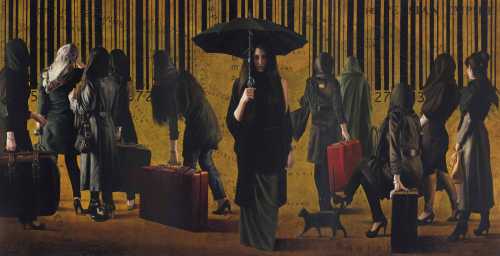About Hamed Sadrarhami
Sadrarhami's paintings belong to the category of neo-surrealist art. Sadrarhami's works are obviously indebted to the legacy of artists such as Salvador Dali and René Magritte, Although, in some of his paintings, he tries to create a link between the traditions of Iranian art and modern painting methods by adding formal elements of painting. This point also puts him in the category of neo-traditionalist painting. This contemporary painter was born in Isfahan. In 2008, he exhibited his works with a group of artists at Apadana Gallery for the first time. He also participated in Tehran Art Expo in the same year. His first solo exhibition was held in Isfahan Artists' House in 2009. Sadrarhami was in charge of the Mehrafam group of painters for some time and was a member of the Image art group. In 2010, a documentary film was made about the life and works of this artist. In 2014, his works were also displayed in a group exhibition titled "Neoclassicism" at the Tehran Museum of Contemporary Arts.
As we said, Sadrarhami can be considered a surrealist painting. But this classification needs to be more accurate. Although his works have undeniable similarities with the works of leading artists of this style in terms of form and the suspension of actual spatial logic and dreaminess, they are not connected with the intellectual cores proposed in the manifesto of surrealist art. In his paintings, Sadrarhami seeks to express external social and political issues rather than opening a window to an individual's unconscious. His references to the Qajar era and its visual manifestations (as a permitted part of the total social and cultural sufferings of Iran's history) are a way to express his opinion on current issues. For example, in some of his works referring to the issue of women, he says: "The women in my paintings are prisoners of the same prison of the Qajar era." Apart from the subjects, his paintings have a pre-modern nature in painting techniques (such as painting methods, representation, volume processing, and the illusion of depth of field). The core of this type of painting is based on finishes and classic realistic representational techniques. His references to Iranian painting do not go beyond formal references, and the contrast between tradition and modernity occurs only in the field of paintings.
The Most Expensive Artwork
At Auctions
First Attendance
30 May 2014
# Attendance
6
# Artworks
6
Average Realized Price
17,295 USD
Average Min Estimate
6,543 USD
Average Max Estimate
9,072 USD
Sell-through Rate
100%
Average Growth of Artwork Worth
121.27%
Timeline
Beyond Imagination exhibition
13 December
Endless Treasures exhibition
21 June
Tehran- 16th- Iranian contemporary art auction
1 July
The last event 1400 exhibition
25 February
The 14th Tehran- Contemporary Iranian Art auction
12 August
What The Pop 2 exhibition
11 December
The 6th Tehran- Contemporary Iranian Art auction
23 December
چهارمین دوره حراج تهران auction
29 May
Modern & Contemporary Arab, Iranian and Turkish Art auction
18 March
سومین دوره حراج تهران auction
30 May
King Nut exhibition
16 May
